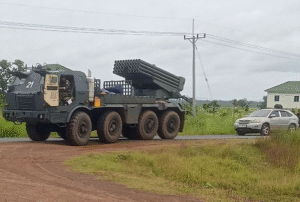Thailand has launched airstrikes on Cambodian military targets in what analysts are calling a dramatic and dangerous escalation of the long-standing border dispute between the two Southeast Asian nations. The airstrikes reportedly targeted military installations, artillery positions, and supply depots along the contested border area near Preah Vihear province, which has been a historical flashpoint for conflict between the two countries.
Early reports from the Cambodian Ministry of Defense confirm that several military outposts were struck, resulting in casualties among personnel and damage to infrastructure. Unverified accounts from local residents describe intense bombing and ground tremors felt kilometers away from the target zones. Smoke was visible from border villages, and civilian evacuations have reportedly begun in nearby communities.
The Thai government has stated that the airstrikes were a “measured and strategic response” to alleged Cambodian incursions and artillery fire earlier in the week. In a press briefing, Thai military officials claimed that Cambodia had deployed armored vehicles and heavy weapons within the disputed territory, prompting what they described as a defensive action to neutralize an “imminent threat.”
Cambodian Prime Minister Hun Manet, in a televised address, condemned the strikes as an act of aggression and a violation of Cambodian sovereignty. He vowed to defend the nation “by any means necessary” and has ordered a full mobilization of troops along the Thai border. Cambodia also called upon ASEAN and the international community to intervene and de-escalate the conflict, urging immediate diplomatic mediation.
Both nations have a long history of territorial disputes, particularly surrounding the area near the ancient Preah Vihear temple, which the International Court of Justice awarded to Cambodia in 1962. Despite that ruling, access routes and adjacent lands have remained contested, leading to multiple armed clashes over the decades, with the last major flare-up occurring in the early 2010s.
Military analysts warn that the current escalation is the most serious in over a decade. Unlike previous skirmishes involving ground troops and light arms, the use of airpower marks a new phase of military engagement. Satellite imagery and open-source intelligence confirm damage to Cambodian infrastructure, including radar systems and ammunition stockpiles.
Regional reactions have been swift. Vietnam and Laos, both ASEAN members and close observers of border stability, have urged restraint. The United Nations has expressed deep concern and called for an immediate cessation of hostilities. The United States and China, both of which maintain close ties with Thailand and Cambodia, have issued statements urging de-escalation and offering to assist with peace negotiations.
The Thai stock market saw a sharp dip following news of the strikes, while Cambodian citizens in border provinces scrambled to find shelter or flee inland. Several humanitarian organizations have begun preparing for a potential refugee situation, citing fears of prolonged conflict that could disrupt regional stability.
Thailand’s Prime Minister defended the strikes as a legitimate form of national defense and warned that any further Cambodian aggression would be met with “greater force.” The Thai parliament is expected to hold an emergency session to discuss the conflict, and military forces have been placed on high alert across northeastern provinces.
Cambodia, meanwhile, has launched its own counteroffensive in response to the strikes, claiming to have downed at least one Thai drone and inflicted damage on a forward Thai base. The Cambodian military has mobilized reserves and deployed surface-to-air missile systems near key locations.
The rapid escalation has sparked fears of a broader conflict, one that could threaten ASEAN unity and regional economic growth. Observers note that both Thailand and Cambodia face internal political pressures that could be fueling nationalist rhetoric and hardline stances.
As of now, both sides remain entrenched in their positions, and diplomatic efforts are underway behind the scenes. ASEAN leaders are expected to convene an emergency summit within days to address the crisis and prevent further bloodshed. In the meantime, border communities on both sides brace for the possibility of additional airstrikes and ground assaults.
The situation remains volatile and fluid, with many hoping for a swift return to diplomacy before the conflict spirals further out of control. The world watches closely as Thailand and Cambodia stand on the brink of war, the consequences of which could reverberate throughout the region and beyond.


